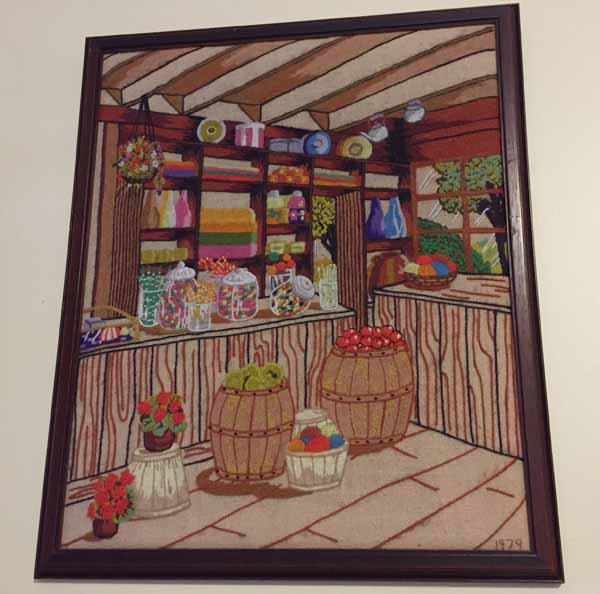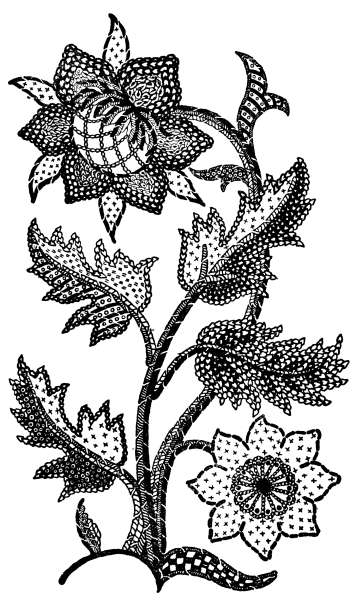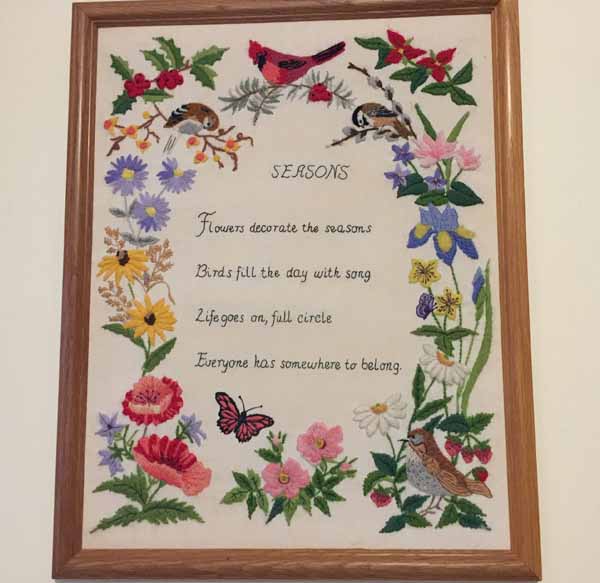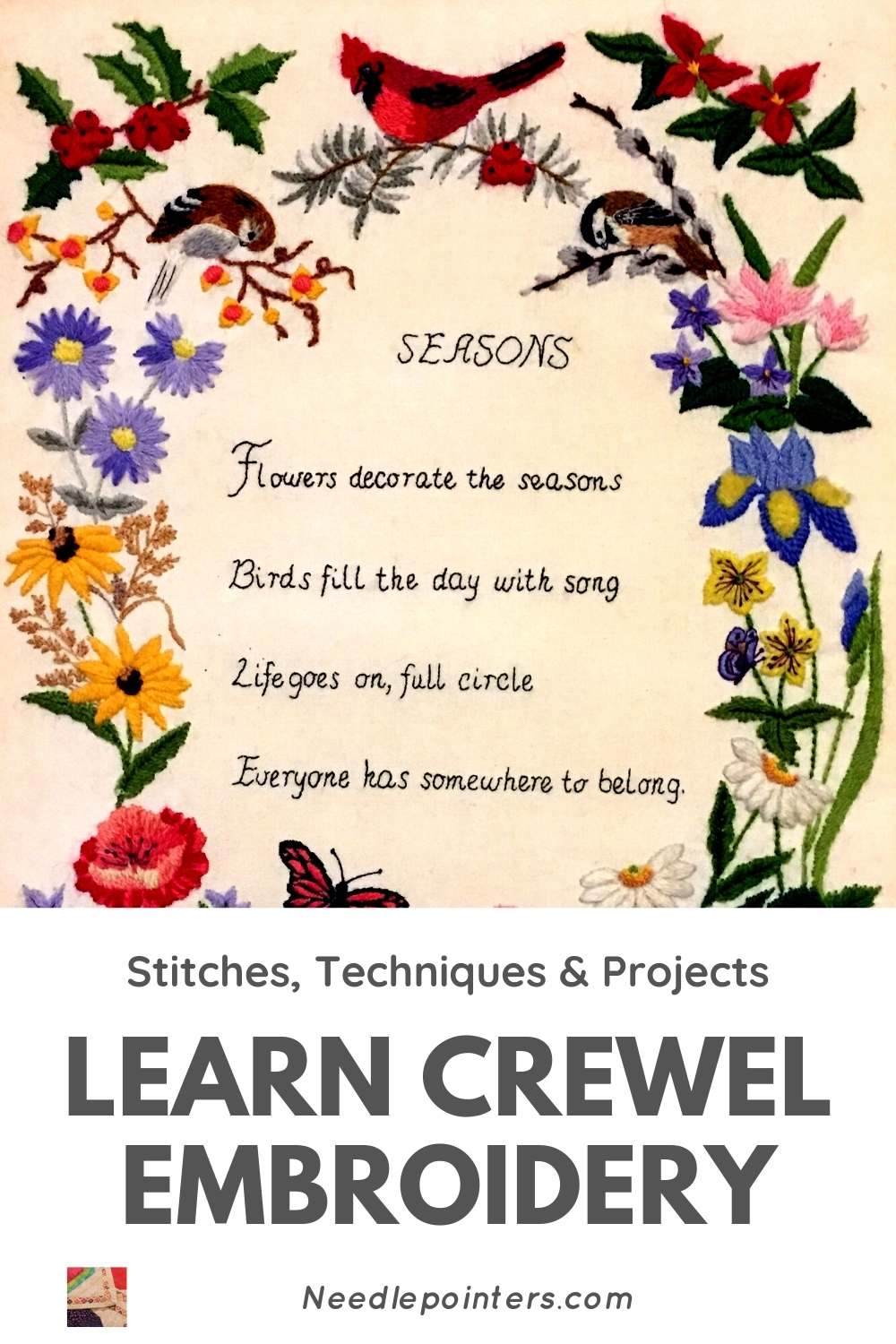Crewel embroidery is a beautiful type of surface embroidery that’s been around for over a thousand years. Traditional crewel work is both about a certain design of embroidery and about the threads that are used.
Crewel thread is a strong thread spun from wool; it is the fiber that technically makes an embroidered item crewelwork.
Crewel work has become increasingly popular, and on this page you will find links to various patterns of crewelwork, stitches used in crewel embroidery, crewel embroidery yarns, and the difference between crewel work and Jacobean crewel embroidery.
Crewel Work
As we said, crewel work is embroidery that is done using wool threads. Because the threads are much heavier than embroidery flosses, the finished designs are much thicker and heavier than that of traditional embroidery.
The rich, textured effect is due to the wool yarn. Unlike cotton embroidery threads, crewel wool is thicker and creates a raised, dimensional feel to the work.
 Crewel Embroidery - Dry Goods Store by C. Sabath - 1979
Crewel Embroidery - Dry Goods Store by C. Sabath - 1979
Like most embroidery, crewel work involves the use of an embroidery hoop. Depending on the size of the piece, small portable embroidery hoops up to some larger, free-standing embroidery frames, which are also known as slates, may be used.
Using these hoops or frames to stretch the surface material tightly before stitching ensures that there is an even amount of tension in the stitches and that the pattern is not distorted.
Crewel embroidery is traditionally done on woven linen twill which has a looser weave than most other fabrics. The looser woven fabric is best able to accommodate the thick crewel yarn, and a firm fabric is required to support the weight of the stitching.
Tightly woven fabrics can be used, but this makes the process more difficult and the yarns will wear much more quickly.
The stitches used in traditional embroidery are also used in crewel work. There is no difference between stitches used in other types of embroidery and those used for crewel embroidery.
Some of the traditional embroidery stitches are used more often in crewel. For example, filling stitches with lattice patterns are very common in crewelwork since many patterns have large surfaces to fill.
Some of the techniques and stitches used are listed below:
- Satin stitches, used to create flat and filled areas within the design
- Couched stitches, used to create a trellis effect within an area of the design
- Outlining stitches such as the stem stitch, the chain stitch, and the split stitch
- Seed stitches applied to give an area of the design a lightly shaded effect
- French knots, used for added texture
- Long and Short soft shading
- Laid and Couched Work
History of Crewel Embroidery
The origin of the word “crewel” is unknown, but many believe it comes from an ancient word describing the curl in the staple, which is the single hair of the wool. Crewel has a long staple; it is fine and can be strongly twisted.
In the early seventeenth century, the word “crewel” meant “worsted” which was a wool yarn with a twist.
Because of this, at the time, crewel embroidery was not identified with particular styles of designs, but rather was embroidery with the use of this wool thread.
Crewel embroidery is often associated with the late sixteenth and the first quarter of the seventeenth centuries during the reign of King James I in England. During this time, large and grand houses were built.
Wealthy ladies used crewel embroidery to create elaborate and expensive bed hangings, cushions, and curtains for their upper-class homes.
They used a method known as the “pinprick and chalk” or “prick and pounce” to transfer the design outlines.
The outlines were printed on paper, and by pricking the outline with a needle to make perforations along the lines, they could then force powdered chalk or “pounce material” through the holes onto the fabric.
This method then replicated the design onto the material.
Jacobean Embroidery
Jacobean embroidery is a term used to describe a style of embroidery design or pattern, rather than an embroidery technique. It is often associated with crewel embroidery.
The pattern, which features strong Eastern influences, was inspired by the ancient Tree of Life, and was designed with fanciful and exotic birds, plants, stags, squirrels and other familiar animals.
 Pattern of a slip with flowers taken from a 17th-century embroidered curtain[2]
Pattern of a slip with flowers taken from a 17th-century embroidered curtain[2]
The name “Jacobean” has its roots in the reign of King James I of England. (In Latin is “Jacobus”). Under his reign, this floral textile design became popular.
Jacobean embroidery is often confused with crewel work, which, as you now know, is surface embroidery done in wool.
Some Jacobean designs were worked in wool, but they were also worked in silk and might incorporate metal threads. Today, Jacobean embroidery designs are worked in a variety of fibers combined to create a stunning effect.
Modern Crewel Work
Although crewel embroidery was most popular in Britain in the seventeenth century, it has come in and out of style many times since then. Today, crewel work continues to be used to adorn curtains and wall hangings, but it is also used to decorate cushions, clothing, lamp shades, and handbags.
The use of a strong wool thread found in crewel work is perfect for upholstered items.
One major difference in traditional crewel work and crewel embroidery today is the large range of colors and kinds of yarn that are available. There are many different kinds of wool and wool-blends to choose from.
You can find traditional Appleton wool, the beautifully smooth Merino wool, and even hand-spun wool mixed with silk, mohair, or alpaca fibers. The color range of the crewel yarn today is at times overwhelming but definitely makes the most beautifully shaded designs.
In regards to crewel patterns, traditional crewel work designs focussed on flowers, leaves, and other motifs from nature; it is now used in modern and abstract patterns as well.
 Crewel Embroidery by C. Sabath - Seasons
Crewel Embroidery by C. Sabath - Seasons
Nearly any design can be crewel embroidered, but you will find that the designs are larger than those of other types of embroidery to accommodate the thicker fibers.
When thinking about the fabric you will use, keep in mind that classic crewel embroidery is worked on linen. However, modern crewel work fabrics consist of jute, silk, cotton, wool, and sometimes even synthetic fabric.
You will also need a special crewel needle. These needles are long and have a large eye to accommodate the thicker yarn.
And be sure not to forget the ever-important tool: your embroidery hoop! The fabric will need to be kept taut just like in any embroidery work.
Crewel work is lovely and is a great way to expand your skills and experience with embroidery.
Take a look at all of the wonderful links below to get you started!!
